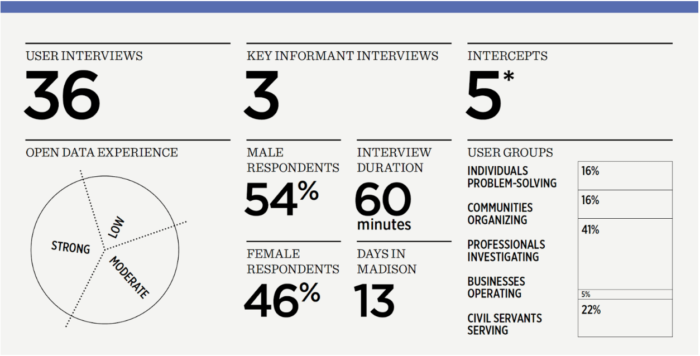Tips for Creating User Personas
In order for open data to be integrated within a culture of civic engagement, open data programs need to meet residents where they are. This can be achieved by using human-centered design techniques like developing user personas. In addition to collecting all the user personas we could find in use in the public sector, we came up with some useful tips for those looking to create user personas.
Our resources on the development of user personas are featured in our new Roadmap to Informed Communities, where we focus on human-centered design strategies for open data. Our hope is that cities will use the persona development tips to host internal workshops to develop personas or to commit to in-depth research to formalize and institutionalize an understanding of government data and information stakeholders.
The right research methods
As with any tool, there is potential to misuse personas. Personas lacking accurate and representative research fail to check assumptions, and can even encourage appealing to stereotypes in decision making.
Open data administrators regularly respond to users with questions about data sets, but the individuals that regularly contact administrators are a small and self-selected group. It is equally important to proactively reach out to communities of people less likely to engage. Talking to community members will ensure government is on the best path to maintaining equitable and impactful open data.
Our tips outline some elements of ethnographic research that can be used to construct personas that accurately and fairly represent residents.
Investing in community research may not always be immediately feasible. That’s why we also offer resources to creating preliminary personas, a simpler, base-level user persona. However, it is important to note that without adequate research, such personas are liable to be misleading. At the end of the day personas are stereotypes, and while preliminary personas can certainly encourage staff to empathize with user needs, they must be considered a mere stepping stone for future iterations of user segmentation research.
Why community-centered open data?
In the face of growing precedent for passing open data policies, we’re doubling down on efficacy. We insist governments serve the interests of their communities, and to that end we encourage city staff to take measurable steps to be in touch with the lives of residents.
Because open data portals serve as central hubs for the flow of information in the community, voices from the community should inform the priorities for portal structure and content. To effectively hear community voices, it’s time for government officials to meet their constituents where they live.
City employees should adopt these design techniques for their own purposes. The tips provide actionable steps to invest in tapping into the cities’ most valuable resource: the experience of their residents. Resident-input is key to cities looking to implement open data policies equitably and with maximum impact.
Personas for public data are meant to engender an environment of understanding and empathy in spaces where people design open data portals. Furthermore, the work that goes into making personas–synthesizing abstract trends from ethnographic research–is converted into a form that is immediately accessible on a human level.
Special thanks to Emily Herrick at NYC Opportunity, Adrienne Schmoeker at NYC Analytics, and Marielle Velander at Reboot for their insights into user discovery, assembling user personas, and open data initiatives.


